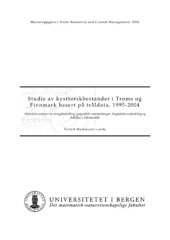| dc.contributor.author | Lunde, Torleif Markussen | eng |
| dc.date.accessioned | 2006-10-16T12:17:04Z | |
| dc.date.available | 2006-10-16T12:17:04Z | |
| dc.date.issued | 2006 | eng |
| dc.identifier.uri | http://hdl.handle.net/1956/1899 | |
| dc.description.abstract | Bestanden av kysttorsken (Gadus morhua) har i følge International Council for the Explorations of the Sea (ICES) og Havforskningsinstituttet (HI) vist sammenhengende tilbakegang siden 1994. Tråldata fra HI i perioden 1995-2004 ble brukt for å beskrive utviklingen av kysttorskbestanden i de ulike fjord- og kystområdene. I denne oppgaven blir kysttorsk i 11 kyst- og fjordområder i Troms og Finnmark studert, og resultatene viser at det i perioden 1995-2004 kun i noen fjorder og lengdegrupper er nedgang. Lengdegruppen 30-35 cm peker seg ut med nedgang, eller ingen utvikling i samtlige områder med unntak av ytre Laksefjord. Generelt viser gruppene 60-65 og 65 cm+ minst tendenser til nedgang. Ytre del av Porsangerfjorden peker seg spesielt ut med negativ utvikling, mens Laksefjord viser få tegn til nedgang. I løpet av den samme perioden ble det ikke funnet store forandringer i lengdefrekvensfordeling i de ulike områdene. Lengdefrekvensfordelingen viser en blanding av nordøstarktisk torsk og kysttorsk. Det var heller ingen klar sammenheng mellom de ulike områdene innad i samme fjord med tanke på fangstmengde med tråltypen Campelen 1800 de ulike årene. Variasjonene i resultatene fra år til år ble forsøkt forklart med en modell som inkluderte solhøyde ved tråling, temperatur på 80-100 m i perioden oktober til desember og bunndyp. Resultatene kan indikere at betingelsene ved tråling ikke er like fra år til år og fra område til område. Torsk så imidlertid ut til å følge et mer bestemt mønster i forhold til solhøyde hvor både kysttorsk og nordøstarktisk torsk ble inkludert. For kysttorsk var resultatene mer varierende. | en_US |
| dc.description.abstract | The population of coastal cod (Gadus morhua) have according to International Council for the Explorations of the Sea (ICES) and Institute of Marine Research (IMR), Norway, declined continuously since 1994. Trawl data from IMR in the period from 1995 to 2004 was used to describe the development of the coastal cod population in 11 fjord and coastal areas in Troms and Finnmark, Northern Norway. In the period from 1995-2004 there was found that only a few fjords and length groups show a clear pattern of decline. The length group 30-35 cm was the group with clearest tendencies of decline in most of the areas. Porsangerfjorden area 4 showed most evidence of decline in population, while Laksefjord on the other hand was showing the opposite. During the same period there was not found any dramatic changes in length frequency distribution in the studied areas. There was neither any clear correlation between the different areas in the same fjord regarding catch with Campelen 1800 among the different years. It was attempted to explain the variations in the CPUE from year to year with a model including sun altitude, temperature at 80-100 m in October-December, and bottom depth. The results might indicate that there are unequal trawling conditions from year to year and from area to area. The sun-effect showed the clearest pattern for a mixture of North-East arctic cod and coastal cod, while less clearly for coastal cod. | en_US |
| dc.format.extent | 3225087 bytes | eng |
| dc.format.mimetype | application/pdf | eng |
| dc.language.iso | nob | eng |
| dc.publisher | The University of Bergen | en_US |
| dc.title | Studie av kysttorskbestander i Troms og Finnmark basert på tråldata, 1995-2004 : statistiske analyser av mengdeutvikling, geografiske sammenhenger, lengdefrekvensfordeling og feilkilder i trålmetodikk | en_US |
| dc.type | Master thesis | |
| dc.rights.holder | The author | en_US |
| dc.rights.holder | Copyright the author. All rights reserved | en_US |
| dc.subject.nsi | VDP::Matematikk og Naturvitenskap: 400::Basale biofag: 470 | nob |
| dc.subject.nsi | VDP::Matematikk og Naturvitenskap: 400::Matematikk: 410::Statistikk: 412 | nob |
